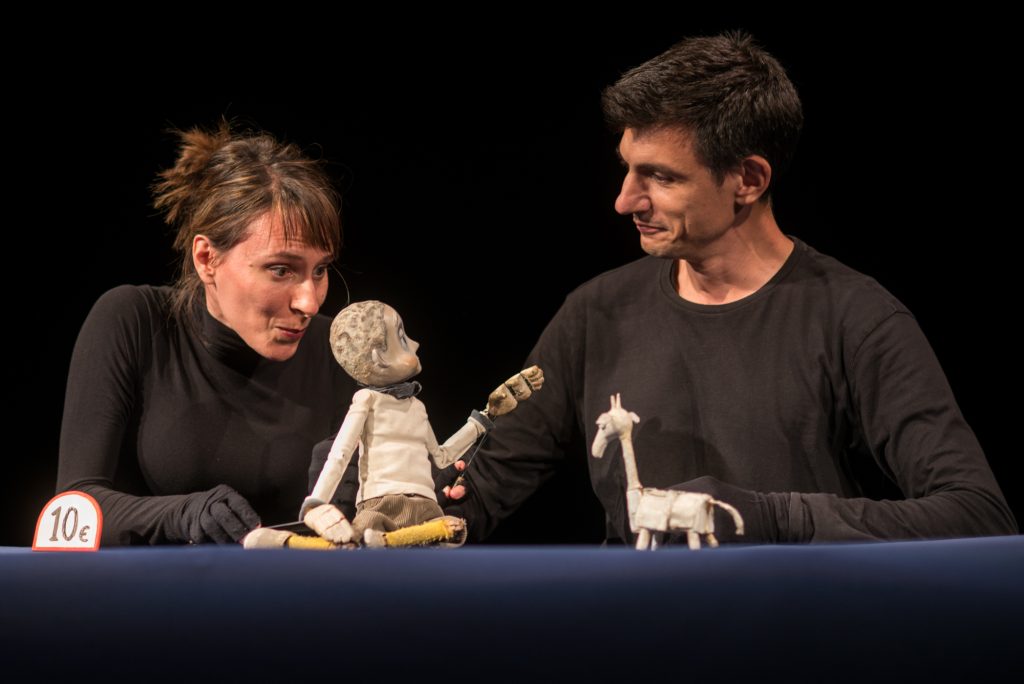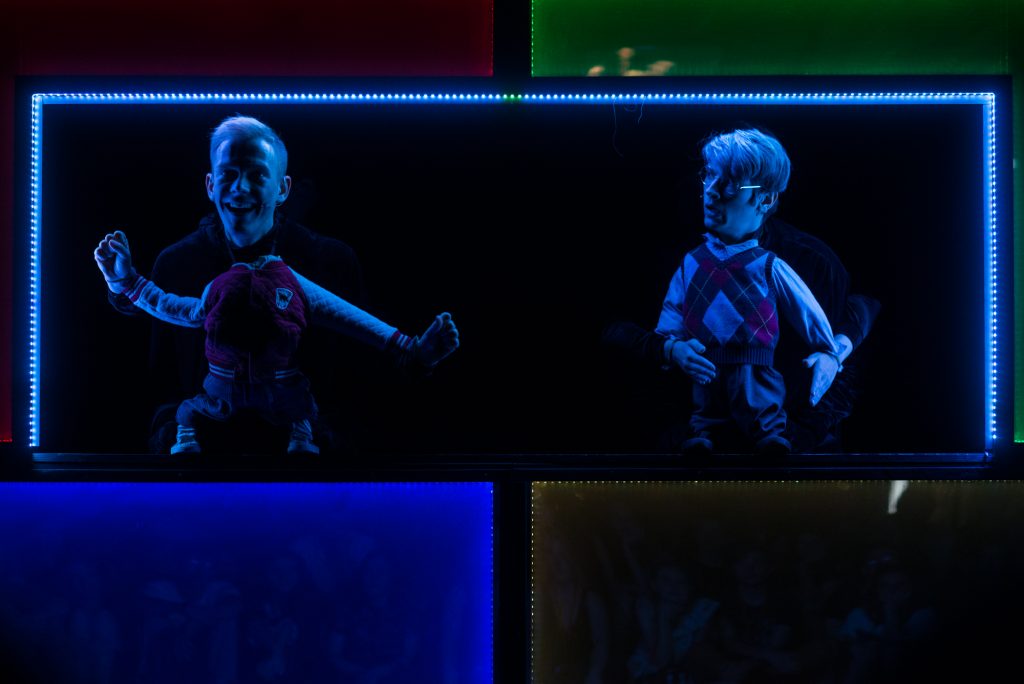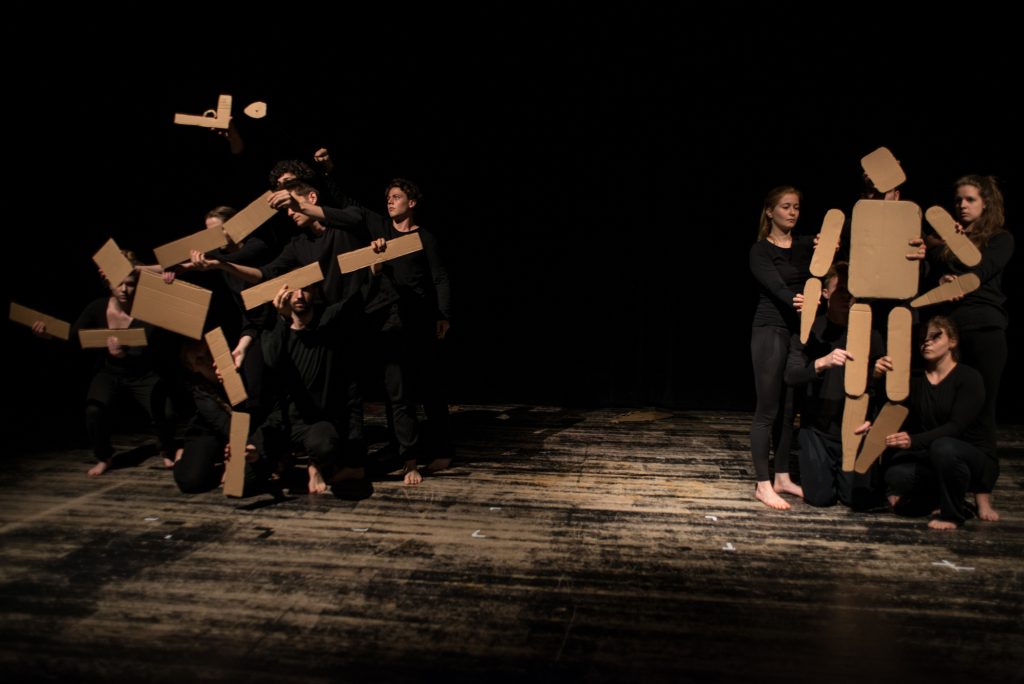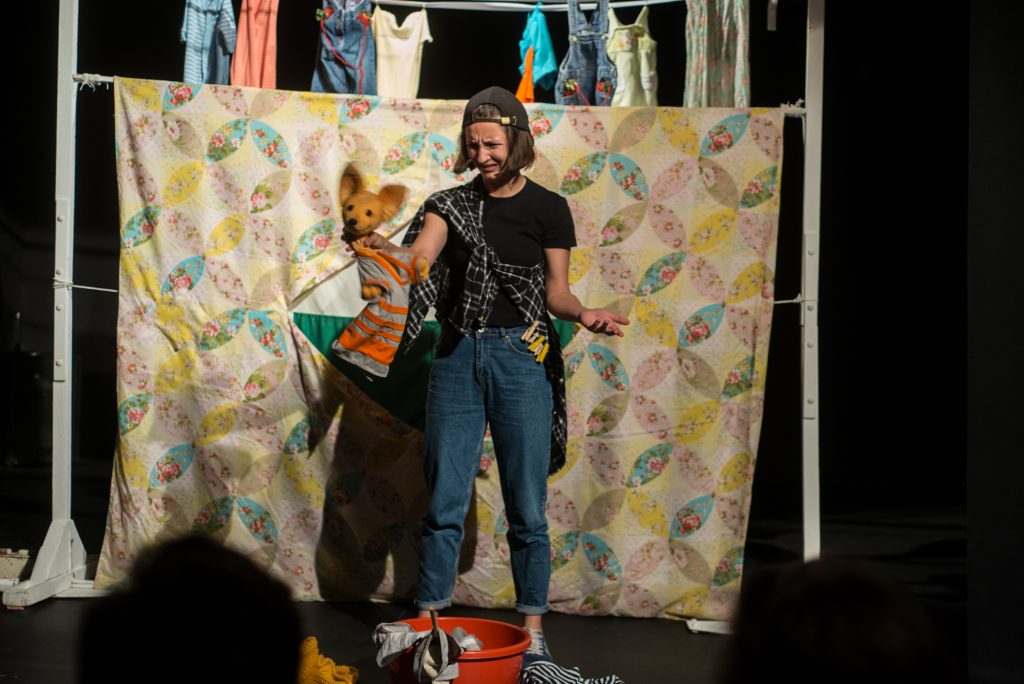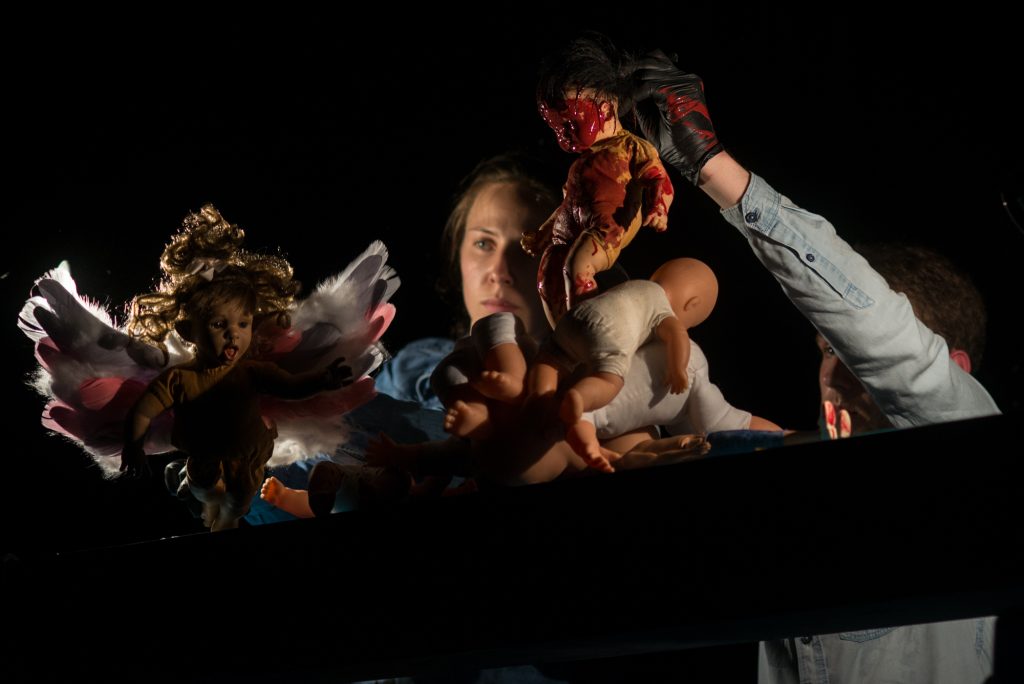Z MORAŁEM, ALE WSPÓŁCZEŚNIE
Teatr, który poucza, daje dobre rady i sprowadza widzów na dobrą drogę jest znany od dawna. Czy jednak jest w stanie wzbudzić emocje we współczesnych widzach? Odpowiedzią na to pytanie mogą być prezentacje ze środowego poranka.
Wzmacniając więzi to propozycja studentów z Łotewskiej Akademii Kultury, inspirowana opowiadaniem „Riču raču” Eriska Adamsonsa. Łotysze zaprezentowali prostą historię opartą przede wszystkim na relacjach syna i ojca. A właściwie na braku tych relacji… Wiecznie zapracowany tata nie znajdował czasu na zabawy z dzieckiem, które nieudolnie próbowało zwrócić na siebie uwagę. Zbieg okoliczności i magiczne moce kostki do gry sprawiły, że bohaterowie przenieśli się do wirtualnego świata Ludo. By wydostać się z niego musieli wykonać kilka misji – od przygód w dżungli i ucieczki przed stadem goryli, przez podwodne przygody i łowienie ryb, po przezwyciężenie współczesnych pokus, jak choćby pęd za pieniądzem. Każdy kolejny „lewel” zbliżał bohaterów, udowadniał im samym, jak ważni są dla siebie. Ostatecznie obaj zgodnie stwierdzili, że najważniejsza jest rodzina. Po powrocie do rzeczywistości postanowili rozegrać przerwaną partię w planszówkę. Niestety, zaczarowana kostka do gry ponownie przeniosła ich do wirtualnego świata.
Wykorzystane w spektaklu tintamareski bardzo dobrze sprawdziły się w konwencji gry komputerowej. Dzięki temu typowi lalek, bohaterowie posiadali pełną mimikę, a lalkowe ciała zdolne były latać, zatrzymywać się w powietrzu, czy wykonywać akrobatyczne ewolucje. LEDowe światła zamontowane w specjalnie skonstruowanym ekranie oraz fragmenty pleksi, w których mogła przejrzeć się widownia, sprawiły, że oglądając łotewski spektakl miało się nieodparte wrażenie, że to my jesteśmy graczami. Należy tylko wierzyć, że nikomu z widowni nigdy nie przyjdzie zmierzyć się z zadaniami stawianymi przez świat Ludo.
Kolejna propozycja, w której twórcy chcieli zostawić nas z konkretną radą jest spektakl „Przebiegły lis” z Kijowskiego Narodowego Uniwersytetu Teatru Filmu i Telewizji. Trójka studentów zabrała nas w podróż do lat dziecięcych, przypominając znaną historię o chytrym lisku i łatwowiernym króliczku. Jednak, z biegiem akcji okazywało się, że to wcale nie rudy spryciarz jest większym łobuzem, ale właśnie niepozorny szarak, który był w stanie przewidzieć każdy z lisich podstępów, a także wejść w spółkę z niedźwiedziem. Połączenie wrodzonego uroku królika oraz sił króla lasu skutkowało licznymi zabawnymi przygodami
i w ostatecznym efekcie przechytrzeniem lisa – jak to zresztą w takich opowieściach bywa.
Artyści wykorzystali w spektaklu jeden z klasycznych gatunków teatru lalek – pacynki. I poradzili sobie z nim po mistrzowsku. Mimo, iż większość akcji rozgrywana była w klasycznym układzie, czyli nad parawanem (stworzonym z poszewki na kołdrę), od czego już odwykliśmy, widzowie chętnie i wielką radością weszli w stworzony przez aktorów świat.
Oba spektakle udowadniają, że mimo upływu lat pewne motywy i teatralne rozwiązania wciąż potrafią cieszyć. Prostota w treści i w rozwiązaniach scenograficznych znajduje swoich wielbicieli nawet w XXI w., natomiast morały w nich zawarte wcale nie tracą na aktualności.
Karolina Dąbrowska
WARSZTAT = TECHNIKA I WSZECHSTRONNOŚĆ
Jestem tu Ja, jesteście tu Wy, są tu oni, tu jesteśmy. Aktor, jako twórca rzeczywistości scenicznej. Właśnie tego doświadczyłem oglądając spektakl „Tu Jesteśmy” w reżyserii studentów pierwszego roku wydziału aktorskiego oraz reżyserii Uniwersytetu Teatru i Sztuki Filmowej w Budapeszcie. Dzięki kooperacji obu wydziałów studenci mogli się nauczyć nie tylko warsztatu, ale i współpracy, która w przypadku reżyser-aktora jest jedną z najważniejszych relacji w teatrze. Wizja spektaklu była laboratoryjna. Studenci pokazali umiejętne opanowanie pracy ciałem, kreatywność, poczucie humoru, ale co najważniejsze byli spójna grupą, co przejawiało się w płynności wykonywanych działań.
Spektakl można podzielić na dwie cześć. Etap grupowy i etap indywidualny. Pierwszy z nich składał się etiudy pokazanej z perspektywy widza oraz „od kuchni”. Studenci wykorzystali zwyczajne kartony do stworzenia potężnych, papierowych animowanych postaci, które ze sobą walczą za pomocą pistoletów a następnie rozczłonkowują, przybierając różnego rodzaju nieokreślone figury lub linie. Tutaj wszystko prezentowane było dokładnie i rzeczowo. Kulminacyjnym momentem tej etiudy było odtworzenia działań Toma Crusa z „Mission Impossible” – niepokonany bohater rozprawiał się z chmarą wrogów, oczywiście wychodząc z opresyjnej sytuacji bez najmniejszego draśnięcia. Cześć „od kuchni” była humorystycznym mrugnięciem oka do widza oraz pokazywała że najlepiej pracuję się poprzez zabawę. Zagrano bowiem tę samą etiudę, tylko w tym wypadku scena odwróciła się o 180 stopni, a my mogliśmy dostrzec jak poszczególne osoby wycinają kartonowe pistolet i działają, aby potem wszystko odbyło się perfekcyjnie. Całość zakończył wspólny, entuzjastyczny taniec.
Etap indywidualny składał się z poszczególnych, najczęściej jednoosobowych etiud, w których wykorzystywano najprostsze przedmioty codziennego użytku, takie jak śmietnik, kubek, garnek. Przedmioty, sprawnie animowane przez młodych aktorów, ukazywały różne stany emocjonalne – od tęsknoty i rozczarowania, aż po entuzjazm i miłość. Posiłkowano się również mimiką twarzy, która w etiudach sprawnie współgrała z muzyką.
Natomiast studenci czwartego roku Państwowego Instytutu Teatralnego w Jarosławiu z Rosji udowodnili, że wystarczą 4 lata, aby nabyć szereg zdolności, które śmiało można zaliczyć do niebanalnych. W półtoragodzinnym spektaklu pod tytułem „Warsztatowo” przedstawili kilkanaście niełączących się ze sobą etiud, które w moim odczuciu były zbiorem egzaminów sesyjnych na przestrzeni wszystkich lat nauki. A różnorodne i zabawne mikropokazy łączyła postać profesora rodem z Muppetów.
Pierwsza scena ukazała nam odmienną od normy perspektywę tańczących nóg. W dalszej części pół kurtyna unosiło się do góry, by stworzyć przestrzeń do grupowych i pojedynczych tańców rąk. Następnie pokazano różnego rodzaju etiudy prezentujące warsztat aktorski: taniec, zdolności cyrkowe, szermierkę, technikę ruchu scenicznego, śpiew, pantomimę. Na największą uwagę zasługują jednak prezentacje z lalkami. Scena teatru czarnego tła, połączona z elementami pantomimy zaprowadził nas w tajemniczą i pełną wrażeń krainę snów. Tworzyły ją lewitujące wokół głównego bohatera elementy, które formowały się w rozpoznawalne postać (m.in. flaminga, czy słonia). Tintamareska Marilyn Monroe połączyła w sobie umiejętność śpiewu z animowaniem lalki. Zaprezentowana została także kultura rosyjska przy pomocy jawajek, które tańczyły we wspólnej choreografii do ludowej muzyki. Każda ze scen posiadała bardzo wyraźny do usłyszenia puls. Finał zakończył się klamrową sceną z wykorzystaniem pół kurtyny, która oddzieliła postacie od aktorów. Ci, zadowoleni i pełni młodzieńczej pasji, pokłonili się widowni.
Oliwer Witek
POPKULTURA – HOT OR NOT
Trzeciego dnia Festiwalu w sekcji szkół lalkarskich mogliśmy oglądać spektakle z Akademii Sztuk Teatralnych im. Stanisława Wyspiańskiego w Krakowie, filii we Wrocławiu oraz Łotewskiej Akademii Kultury. Zarówno w „Open the dor, man!” jak i w „Hrabi Monte Christo w 30 minut” twórcy wyraźnie inspirują się popkulturą, przekładając ją na lalki oraz fragmenty muzyczne.
Na całość „Open the dor, man!” składało się kilka indywidualnych etiud, a każda z nich bazowała na innym, losowo wybranym fragmencie literackim. To połączenie ze sobą kompletnie rozbieżnych scen wywołało jednak poczucie przytłoczenia i tracenia uwagi u widza. Studenci zaczynają mocnym wejściem. W tle słyszymy zapętlony głos Jana Dormana (bo spektakl to ukłon w stronę mistrza i jego poszukiwań w przestrzeni happeningu oraz performansu). Nagle rozległ się odgłos dobijania do drzwi, a na horyzoncie pojawiły się niebieskie litery układające się w napis OPEN THE DOR, MAN! Już po chwili animowana zostaje lateksowa lalka z sex-shopu. Jest kochanką transseksualnego mężczyzny, a ich relacja opiera się na agresji i wzajemnej fascynacji. Następna scena rozpoczęła się od przypadkowego wylądowania postaci w wodzie podczas skoku ze spadochronu. W tle – soundtrack z „Mission Imppossible” (kolejny raz w spektaklach tego dnia!). Ken, będący męskim odpowiednikiem słynnej Barbie, pluskał się w akwarium w takt kiczowatej, elektronicznej muzyki. I nagle pojawił się wątek uchodźców. Z tyłu został wyświetlony fragment materiału dla dziennika informacyjnego, a na nim, tłumy zmierzających do Europy. Większość z nich straci wkrótce życie, ale słyszymy roztargnione słowa pilotki, że „nikt tej nocy nie zginął, oprócz jednej dziewczyny”. Szkoda, że zarysowana sytuacja w tym przypadku nie jest przejmująca, ponieważ temat, tak zresztą ważny, nie został rozbudowany, a ledwo napomknięty. Już za chwilę, w miejsce poprzedniego nagrania, zostaje wyświetlona animacja z czarno-białymi, ruchomymi paskami i całującą się parą. A gdyby komuś było mało, to mamy też sceny z gospodynią domową wystylizowaną na pinup-girl lub z Chudym z „Toy Story”, oceniającym charakter kobiety na podstawie ułożenia jej nóg, gdy siedzi.
Pomysł wykorzystania lalek wielokrotnie przetworzonych przez kulturę masową ma ogromny potencjał, lecz ten zabieg umyka uwadze właśnie przez nagromadzenie dużej ilości kompletnie niewspółgrających ze sobą wątków.
Łotewscy studenci z kolei podjęli się przełożenia na scenę ponad 1000-stronnicowej powieści Aleksandry Dumasa – „Hrabiego Monte Christo”. Licznik na dole cały czas odmierzał czas, a tego, na tak obszerną akcję, było naprawdę mało. Często musiała się ona rozgrywać symultanicznie, nie powodując przy tym chaosu. Dyscyplina czasowa skutkowała dyscypliną we wprowadzaniu kolejnych wydarzeń, a te były prowadzone z lekkością i dowcipem. Do tego przyczyniło się umiejętne animowanie stolikówek jak i lalek znanych nam z witryn sklepowych – Barbie i noworodków. Ich sposób ożywiania często przypominał ten, gdy bawi się nimi kilkuletnie dziecko, ale w połączeniu z muzyką nadawało to postaciom wyraźnej groteskowości i komiczności. I tak: w trakcie sceny ślubu usłyszeliśmy wymęczone przez radio i imprezy karaoke „My heart will go on”; podczas jednej z imprez lampki świąteczne odbijają się od twarzy Barbie tak jak lasery na imprezach klubowych, a w tle przewija się kojarzony przez wszystkich utwór techno; z kolei gdy Hrabia spotkał na swej drodze węże, które zwinnymi ruchami przybliżały się do swej ofiary, pojawiło się Toxic Britney Spears. Posługiwanie się nieustannie muzyką popularną spowodowało, że natychmiast mieliśmy nakreśloną atmosferę sceny, gdyż w ciągu 30 minut nie ma czasu na subtelności i rozbudowywanie każdego z wątków.
Umiejętne wykorzystanie elementów z kultury masowej przyczyniło się do tego, że spektakl stał się bardzo spójny, a co najważniejsze – atrakcyjny dla widza.
Aleksandra Sidor
PROSTE – CZYSTE – PIĘKNE
Dwójka aktorów, kobieta i mężczyzna, sceny kameralne, oszczędność w scenografii, brak słów, prosty temat – to łączy dwa ostatnie spektakle, które mogliśmy obejrzeć trzeciego dnia festiwalu. Nie trzeba dużo, żeby zachwycić i wzruszyć. Mniej znaczy więcej.
Świat może się składać ze stołu, dwóch krzeseł i starych okiennych framug. W pokazie warsztatowym „Cienie w południe” przestrzeń nie tylko została w taki sposób zbudowana, ale też wielokrotnie zdekonstruowana. Czarne tło, biała, drewniana konstrukcja i dwójka szarych ludzi (typowych everymanów) to aż nadto, aby stworzyć liryczną opowieść o relacji kobiety i mężczyzny. Choć bohaterowie zdawali się nawzajem nie widzieć, to ich skupienie sprawiało wrażenie, że czują swoją obecność. Podczas niespełna trzydziestominutowego pokazu w małej, intymnej atmosferze, byliśmy świadkami codziennych obowiązków, takich jak gotowanie, czy szykowanie się do wyjścia. Po kilku sekwencjach ruchowych z przedmiotami, doszło w końcu do spotkania bohaterów. Nie była to jednak oczywista sytuacja, gdyż odbywała się przez blat stołu za pomocą rytmu wybijanego palcami. Kobieta i mężczyzna postanowili siebie odnaleźć. Podczas szukania, przestrzeń zmieniła się w tor przeszkód, w którym aktorzy błądzili niczym w labiryncie. Ich motywacja okazała się niewystarczająca do tego, aby mogli się dostrzec w miejscu, w którym nie ma gdzie się schować. W końcu usiedli przy stole, ale dalej siebie nie widzieli. Dzieliło ich tak niewiele, a jednak zbyt dużo.
Studentka z Wydziału Sztuki Lalkarskiej w Białymstoku i jej łotewski partner nie opowiedzieli spójnej, linearnej historii. Dali nam dużo więcej – możliwość ułożenia sobie w głowach historii relacji dwójki bohaterów. Stało się tak dzięki skromności środków wyrazu – scenografii, kostiumów – oraz prostocie tematu. Na duże uznanie zasługuje dopracowanie i czystość w ruchu, który stworzył na scenie pewnego rodzaju taniec dwójki samotnych ludzi.
Relacje – to temat, z którym wyszliśmy z pokazu granego w AT, i którego kontynuację zobaczyliśmy w spektaklu „Żyrafa” ateńskiego teatru lalek Hop Signor. Po raz kolejny weszliśmy w minimalistyczną przestrzeń składającą się z reflektorów i nakrytego niebieskim materiałem stołu. Dwójka aktorów stała się rodzicami małej lalki stolikowej. Czułość, z jaką obchodzili się z chłopcem zrobionym z drewna i papier-mâché podobna jest do pozycji rodzica, który kształtuje świat małemu dziecku, uczy je chodzić i poznawać rzeczywistość, a także stawia mu granice. Lalka na naszych oczach ożyła. Jej płynne ruchy, dopracowane w najmniejszych szczegółach sprawiły, że publiczność entuzjastycznie reagowała na sytuacje, które zdarzały się małemu bohaterowi.
Rodzice uczyli też chłopca wartości pieniądza. Dali mu skarbonkę w kształcie żyrafy i gestycznie pokazali, że za zaoszczędzone pieniądze w przyszłości będzie mógł kupić sobie upatrzony samolot. Dążenie do marzeń okazuje się ważniejsze niż samo spełnienie. Żyrafa z narzędzia konsumpcjonizmu stała się przyjacielem, droższym od kosztownego bibelotu. Lalka przejęła kontrolę nad przestrzenią i sama stała się animatorem. Z miski stworzyła łódkę, z łyżki wiosło i razem ze swoim zwierzęcym kompanem wyruszyła w morską podróż. Daleko od domu, zwróciła przyjacielowi wolność. Żyrafa w nowym miejscu stała się po raz kolejny towarzyszem, który spełnia życzenia. To dzięki niej stary skąpiec mógł poczuć się jak ptak i wznieść się ponad swoje ograniczenia.
Okazuje się, że proste historie są najpiękniejsze. Wymyślne plastyczne zabiegi często mają za zadanie przysłonić płytkość opowieści. Zarówno spektakl młodych studentów jak i doświadczonych greckich artystów nie musiał nic ukrywać i pokazał, że ważna jest wyobraźnia, dopracowanie i czystość detalu.
Karolina Pawłoś
EDUCATIVE, BUT MODERN
Theatre that educates, gives good advice and brings spectators to the right track has been known for ages. Is it however able to evoke emotions in contemporary spectators? The presentations from this morning can answer this question.
“Strengthening bonds” is a proposition of the students from Latvian Academy of Culture, inspired by the story Riču raču written by Erisk Adamsons. Latvians presented a simple story based mostly on a relationship between a father and a son. Or its lack…
The busy father did not find time to play with his son, who clumsily tried to catch his attention. A coincidence and magical powers of the dice caused that the characters were transferred into a virtual world called Ludo. In order to get out, they had to finish a few missions – from the adventures in a jungle and a runaway from a herd of gorillas through underwater adventures and fishing time up to overcoming contemporary temptations, like the act of chasing for money. Each consecutive “level” made the characters closer and proved how important they are for each other. Finally, both of them agreed that family is more important than anything else. After the return to reality, they decided to play the aborted game one more time. Unfortunately, a magic dice once again transferred them into the virtual world.
Tintamerresques used in a performance worked perfectly in a convention of a computer game. Thanks to this type of puppets, the characters still used their own mimics, and their puppet-like bodies were able to fly, stop in the air or do acrobatic evolutions. LED light installed in a specially constructed screen and plexi fragments, in which the spectators could see themselves caused that while watching the Latvian performance we had the impression that it is us that play the game. One should only believe that none of us will ever face the tasks given in Ludo world.
The next proposition, in which the artists wanted to leave us with a concrete advice is a performance “A Tricky Fox” from Kyiv National I. K. Karpenko-Kary Theatre, Cinema and Television University. Three students took us into a journey to childhood by refreshing the story of a tricky fox and naïve rabbit. However, with time it turned out that it is not a red trickster who is a greater rowdy, but actually a tiny greyish bunny, who was able to foresee each trick prepared by the fox. And he even made a deal with a bear. The marriage of an ingrained charm of a bunny and strength of the king of the woods resulted in numerous funny adventures that led to outfox a fox – as it happens in such stories.
The artists used one of the most classical puppet techniques – hand puppets. And they turned out to be masters in this technique. Despite the fact that most action was organized in a classical way, that is over the screen (created out of pillowcase) that we are not used to nowadays, the spectators eagerly and with great joy entered the world created by actors.
Both performances prove that despite the flow of years, certain motives and theatrical solutions can still fascinate. Simplicity in content and scenographical solutions find their lovers even in the XXI century, and educational aspects that are ingrained in the stories are still up-to-date.
Karolina Dąbrowska
SKILLS = TECHNIQUE AND VERSATILITY
I am here, You are here, they are here, we are here. The actor as the creator of stage reality. I have just experienced it while watching the performance “Here we stand” directed by first year students from the University of Theatre and Film in Budapest (acting and directing specialization). Thanks to cooperation of those two specializations, the students were able to achieve skills but also try the teamwork, which in case of directors and actors is one of the most important things in theatre. It was a kind of a laboratory. The students presented their abilities while working with their bodies, their creativity, sense of humor, but most of all worked as a team, which was visible in the fluency of the presentation.
The performance can be divided into two parts. Group work and individual work. The first one was the group etude shown from two perspectives – the spectator’s and actor’s perspective. They used cartoon paper to create huge characters who fight against each other with guns. And the actions resembling the ones of Tom Cruise from Mission Impossible created the climax of that part – invincible character defeated the enemies, without any harm on his side. The ‘from the inside’ part was treated with a pinch of salt and proved that one works best when one has fun. The same etude was played with only one change. The stage turned 180 degrees and we were able to notice how particular students prepare next movements to make it look perfect. The whole etude ended with a joint enthusiastic dance.
Individual part consisted of series of etudes, mostly with one person involved, in which every-day objects were used, such as a bin, a cup, a pot. The objects, animated by young actors, presented different emotional states – missing, disappointment, enthusiasm and love. The students worked also on their mimics, which worked in accordance to music.
On the other hand, the students of the fourth year of National State Theatre Institute from Novosibirsk proved that four years are enough to learn the skills, which can surely by called unique. In their presentation lasting over an hour and entitled “Inside the Workshop” they presented more than a dozen of independent etudes, which in my opinion were a kind of a mixture of exam presentations from four years of their studies. These diverse and funny micro-shows were linked with a character of a professor looking just like one of the famous Muppets.
The first etude presented an unusual perspective of dancing legs. And then the curtain went up to give space for the group and individual dances of hands. Next, there were different etudes presenting performing skills: dance, acrobatics, fencing, stage movement technique, singing, pantomime. But the scenes with puppets deserve most attention. Black theatre etude linked with element of pantomime led us into a mysterious land of dreams created by elements floating around the main character, which formed into recognizable shapes (e.g. flaming, elephant). Marylin Monroe’s tintamerresque show linked the skills of singing and puppet animation. An inspiration of Russian tradition was visible in the etude with rod puppets, which danced in a joint choreography accompanied by folk music. Each scene possessed its own pulse. The final scene used a curtain that separated the actors from the characters. And the satisfied students bowed to the audience, filled with passion and contentment.
Oliwer Witek
POPCULTURE – HOT OR NOT
On the third day of the Puppetry Schools Festival we could see performances from the AST National Academy of Theatre Arts, Puppetry Department in Wroclaw and the Latvian Academy of Culture. It is clear that in both performances “Open the dor, man!” and “Count Monte Christo in 30 minutes”, the artists are clearly inspired by pop culture, transferring it into puppetry art and linking it with music.
“Open the dor, man!” consisted of few individual etudes, and each of them based on a different, randomly chosen, literary fragment. However, the mixture of completely contradictory scenes evoked the feeling of overwhelming and resulted in spectators’ distraction. The students started with a powerful entrance. We heard a looped voice of Jan Dorman (while the performance is a bow towards the master and his search in the space of happening and performing art). Suddenly, we heard a knock on the door changing into an inscription OPEN THE DOR, MAN! And after a while we saw a latex puppet straight from the sex-shop. She turned out to be the lover of a transsexual man, and their relation was based on aggression and mutual fascination. The next scene began with an accidental parachute jump of a character into the water. In the background – we hear the soundtrack from Mission Impossible (one more time today!) Ken, being a male equivalent of a famous Barbi toy swam in the waters of the aquarium to the rhythm of kitsch, electronic music. And suddenly, the plot of refugees appears. In the background, we could see the fragments of TV material presenting hordes of people heading for Europe. The majority of them will die soon, but we hear the pilot’s words that “nobody died this night, except for one girl”. It is a shame that the outline situation is not deeply moving, but the theme was not deeply analyzed but rather merely mentioned. In a moment, in the place of the previous recording, black&white animation was shown with movable stripes and a kissing couple. And if someone wanted more, there was also a scene with a house lady looking just like pinup girls or with Tiny from Toy Story, estimating a character of a woman basing on her legs when she sits.
The idea to use puppets numerously processed by mass culture has a great potential, but this time it has not worked as it should mainly because of the accumulation of huge number of completely different plots that do not match one another.
Latvian students, in turn, tried to present an over 1000-page long novel of Alexandre Dumas – Count Monte Christo. The clock down counted the time and it was too short to tell such a story till the end of it. Often, it had to be played simultaneously, not causing chaos at the same time. The time discipline resulted in discipline while introducing consecutive events, and these were introduced in a light and funny way. It was surely due to a skillful animation of table puppets as well as toys we know from shops – Barbie and baby toys. Studemts’ way to give life to them resembled the one of children playing with toys, but linked with music it gave the puppets animation another dimension, comism and grotesque. And so: during the marriage scene we heard “My heart will go on” piece, heard thousand times in the radio and sung thousand times during karaoke parties; during one of the parties, Christmas lights reflected Barbi’s face just like lasers in club parties, and in the background we heard easily recognizable techno music; and when the Count met snakes on his way, which skillfully approached to their prey, we heard “Toxic” sung by Britney Spears.
The use of popular music resulted in the instant creation of the atmosphere of each scene. During 30 minutes, there is no time for subtleties.
The skillful use of music from mass culture made the performance coherent, and what is most important – very attractive for the spectator.
Aleksandra Sidor
SIMPLE-PURE-BEAUTIFUL
Two actors, a man and a woman, studio scenes, modesty of scenography, lack of words, simple theme – these are the links between two last performances, which we could watch on the third day of our festival. There is no need to have much in order to amaze and move. Less means more.
The world can consist of a table, two chairs and old window frames. In the workshop presentation “Shadows at noon”, the space was not only constructed in this way, but it was also deconstructed numerous times. Black background, white, wooden construction and two grey people (typical everymen) is even too much in order to create a lyrical story about the relation between a man and a woman. Although the characters seemed not to notice each other, their focus caused that they somehow sensed their presence. During less than 30 minutes of an enclosed, intimate atmosphere, we became witnesses of every-day duties, such as cooking, or preparing to go out. After a few sequences with objects, the meeting of the characters finally happened. However, it was not an obvious situation because it happened through the table in the form of rhythmical tapping of their fingers. A man and a woman decided to find themselves. During this search, the space changed into an obstacle course, in which the actors wander as in a kind of a labyrinth. Their motivation turned out to be insufficient in order for them to see each other in the place, where there is no place to hide. Finally, they sat at the table, but still not seeing each other. They were separated by almost nothing, but it was still too much.
A student of Puppetry Theatre Art Department in Bialystok and her Latvian partner did not tell a coherent, linear story. They gave us much more – the possibility to think through the story of those two people in our own heads. It happened thanks to the modesty of used means of expression – scenography, costumes – and the simplicity of the theme. The perfection and clarity of movement should be appreciated. It created a kind of a dance of those two lonely people on stage.
Relations – this is a theme, with which we left the presentation presented in Theatre Academy, and which continuation we saw in the performance “Giraffe” from the Hop Signor Theatre from Athens. One more time, we entered a minimalistic space consisting of lights and a table covered with blue material. Two actors became parents to a little table puppet. The tenderness, with which they treated a boy made out of wood and papier-mâché is similar to the one of the parent, who shapes the world of a child, teaches how to walk and explore reality and also makes boundaries. A puppet started to live in front of our eyes. Its fluent movements, worked out in the smallest detail caused that the audience enthusiastically reacted at the happenings on stage.
Parents also taught the child the worth of money. They gave him a moneybox in a shape of a giraffe and showed him that he will be able to buy himself a plane in the future if he saved money. And aiming at one’s dreams turned out to be more important than the sole accomplishment. The giraffe ceased to be only a tool of consumptionism, but became a friend, more precious than a worthy object. A puppet took the control over the space and became an animator itself. It created a boat out of bowl, a paddle out of a spoon and accompanied by his own animal friend set off for a sea journey. Far away from home, he returned the giraffe her freedom. In a new place, the giraffe became once again a companion that fulfill dreams. Thanks to the giraffe an old greed was able to feel like o bird and to fly above his own constraints.
It turned out that simple stories are the most beautiful ones. Complicated visual scenographies often cover the shallowness of the story itself. The performance of young students as well as experienced Greek artists did not have to hide anything and proved how important imagination, precision and clarity of detail are.
Karolina Pawłoś
Fot. Tobiasz Czołpiński

